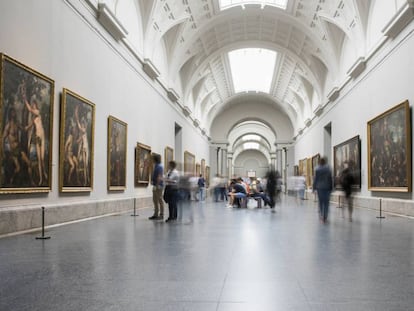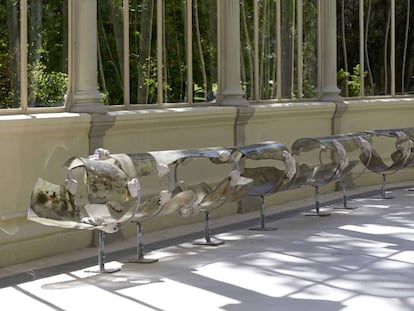The Prado¡¯s treasures come to life
Rino Stefano Tagliafierro injects computer-generated movement into the art collection in a video produced by El Pa¨ªs Semanal for the 200th anniversary of one of the world¡¯s most famous museums

The boy stares ahead, serious and brooding. You might be forgiven for thinking he was alive, if it wasn¡¯t for the fact that he has been perfectly still ever since 1859, when V¨ªctor Manzano painted this portrait. And then, suddenly, he blinks. It is a split second but you catch it ¨C and this is the essence of 39-year-old Rino Stefano Tagliafierro¡¯s work. ¡°It should last as long as it takes to draw a breath; it shouldn¡¯t go over the top,¡± says Tagliafierro, referring to the life injected into the frame.
In 2014, Tagliafierro discovered the ideal vehicle for teaming his creativity and his passion for art: bringing the great masterpieces of our time to life. His first stab at the medium was Beauty, a short nine-minute film that deals with life and death and brings movement to renowned paintings such as David and Goliath by Caravaggio and others that are more obscure. The film caused a stir in his native Italy that exceeded his own expectations. Five years on, his technique perfected, Tagliafierro raises the bar and brings the masterpieces of the Prado Museum to life.
To celebrate the gallery¡¯s 200th anniversary, the contemporary artist and his colleagues have come up with a video, produced by El Pa¨ªs Semanal, animating 30 of the museum¡¯s artworks. These include Young Boy Seated by Manzano to Saturnina Canaleta by Madrazo, The Garden of Early Delights by Hieronymus Bosch and The Three Graces by Rubens.
It¡¯s not about showing that I know how to do animation, nor is it about overdoing it to the point of being kitsch
Rino Stefano Tagliafierro
The film is titled Beauty and Madness and the pictures themselves have been specifically chosen to tell a story, express a feeling or produce a contrast. ¡°It¡¯s not about showing that I know how to do animation, nor is it about overdoing it to the point of being kitsch. The key is to tell a story and bring out hidden aspects while maintaining a balance between the original work and where I¡¯ve intervened,¡± says Tagliafierro in his Milan studio.
The intervention is minimal. The chaos of the Third of May by Goya, which depicts the suffering and terrors of the Peninsular War in 1808, involves just three seconds of the man in the white shirt waving his arms as he asks to be pardoned, the French soldiers raising their rifles and another prisoner turning his head to avoid witnessing the execution. The drums roll. And then the story moves on to The Great He-Goat and The Witches¡¯ Sabbath, also by Goya. And so it continues for almost four minutes with a soundtrack to help the narrative along.
The film may only last four minutes, but it took Tagliafierro four hours to make his selection, stalking the rooms of the Prado in search of the right material. At first he picked out 150 paintings and then began a process of elimination, depending on whether the paintings fit his vision. He then spent a month working on the selection on his computer.
¡°It¡¯s not very glamorous,¡± says Tagliafierro, crossing the threshold of Karmachina, the workshop he has set up with several other professionals. It is a fairly mundane space filled with white tables and shelves ¨C in fact the screening corner is perhaps the only indication that anything creative goes on in here.
Tagliafierro moves his cursor across his computer screen. He selects Dana? and the Shower of Gold, a painting by Titian. ¡°Once I have downloaded the paintings in high resolution, I identify all the things I want to animate,¡± he says, adding they usually amount to around 50 elements per painting. He cuts the arms, the phalanx bone of the hands of the people featured, the curtain and in this case, each drop of gold.
With a clean digital snip, Tagliafierro cuts Dana?¡¯s head off, leaving a blank space. Now starts the ¡°digital restoration¡± ¨C if the woman¡¯s head moves to one side due to the animation, the area it previously occupied has to be filled. So Tagliafierro imagines, compares and zooms in until he sees the original brushstrokes and their direction and then he starts painting himself on screen to fill in the gap.
In spite of his attention to detail, Tagliafierro has attracted his share of criticism. He has been told that he desecrates the art and then the question arises: Why should these paintings be animated in the first place? ¡°Why not?¡± he retorts. ¡°At the end of the day, art has often taken the past as a point of departure to make something more contemporary.¡±
Tagliafierro has been told by critics that he desecrates the art
Tagliafierro is a lot less clear about how he came to embark on this journey. He utters a sound like ¡°Boh!¡±, the Italian equivalent of ¡°who knows?¡± When he was little, his parents took him to exhibitions, like one of Salvador Dal¨ª that made a lasting impression on him before he had even reached adolescence. He then went on to study art, but took a few dud turns. At one point he helped with the family restaurant while making promotional videos for a demolition company that was trying to sell futuristic machinery. ¡°It devoured the buildings,¡± he recalls.
Eventually, he got back on track and currently does anything from installations to video-mapping, publicity for big brand names to video clips. And then there is Karmachina, which has a range of projects on the go at any one time.
Even so, Tagliafierro does not consider himself to be an artist as such. He says he doesn¡¯t really know what the word means. ¡°I am outside of the art world. Far away from it. It¡¯s dirty. Like the fashion world, but in a more insidious and less obvious way,¡± he says. ¡°There, I¡¯ve said it. I¡¯m not going to get another contract ever again!¡± Who knows. Perhaps, like in his own work, someone will make an unexpected move.
English version by Heather Galloway.


